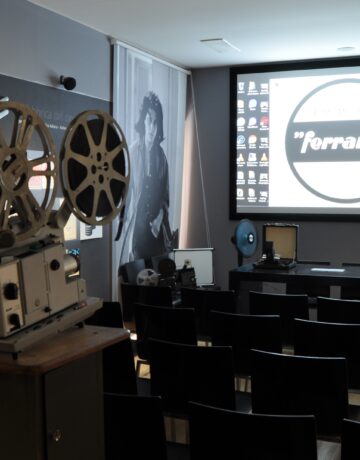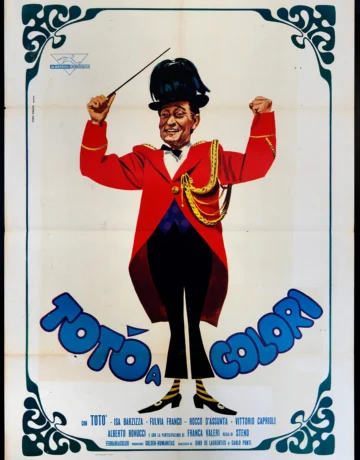The Cinematographic Film
The cinematographic film
 In 1923 the first production of positive cinematographic film was presented by F.I.L.M. at the Turin International Exhibition of Optical Photography and Cinematography. In 1927 was realized the negative photographic film which shows images which have their colours inverted after development, while the positive one is a transparent film displaying a positive real image, typically used in printing processes. Despite the strong crisis of cinema in the ’20s, the work continued, sound is perfected and from orthochromatic films – not sensitive to red- switching to panchromatic. The ’30s were favourable because of fascist propaganda that invested in the film industry, Cinecittà Studios opened in 1937. In the next year the film Friendship inaugurated the Pancro C5 negative film and, immediately afterwards, the C6 version named Italian negative came.
In 1923 the first production of positive cinematographic film was presented by F.I.L.M. at the Turin International Exhibition of Optical Photography and Cinematography. In 1927 was realized the negative photographic film which shows images which have their colours inverted after development, while the positive one is a transparent film displaying a positive real image, typically used in printing processes. Despite the strong crisis of cinema in the ’20s, the work continued, sound is perfected and from orthochromatic films – not sensitive to red- switching to panchromatic. The ’30s were favourable because of fascist propaganda that invested in the film industry, Cinecittà Studios opened in 1937. In the next year the film Friendship inaugurated the Pancro C5 negative film and, immediately afterwards, the C6 version named Italian negative came.
In the reorganization of Italian cinema sector, also after the World War II, Ferrania remained one of the leading technological company.
From 1946 to 1965, in cinema halls, before the movie screening, La Settimana IN.CO.M. (The IN.CO.M Week) heir of the newsreels of the Istituto Luce, shot on Cine Pancro C7 film was shown. The Ferraniacolor, and the P30, Black and White Pancromatic film, that were mostly used and appreciated by expert cinematographers and enhanced by directors such as Vittorio De Sica and PierPaolo Pasolini, made those years a very fortunate period for the company.
The colour season ended soon, in fact, in 1957 I.F.I. (the Agnelli’s family financial company, the owner of Ferrania) decided to invest in Technicolor Italia, the roman plant for the film development and printing. Many technicians are diverted to the new reality, including Giulio Monteleoni, former head of the Colour Research Laboratory, so Ferrania begins to produce Technicolor film for international laboratories.
In the so-called golden years of cinema, in which, among the customers of Ferrania, there were also MGM, Paramount, Universal, 20th Century Fox, kilometers and kilometers of film were produced, especially for the positive printing of the copies to be projected (among the products we find the 3M Color 650).
The decline of the company was rapid, due to the advent of TV and magnetic recording and consequently the roman branch of the company, opened in 1958 in Via Appia, near Cinecittà Studios, produced its last movie in 1982 after which it was shut down.
Action!
In the 50s and 60s a close relationship was established between the Company and the world of cinema, particularly in the Cinecittà Studios. The Ferrania brand accompanies the season of neorealism and comedy on the big screen like Cronache di un amore (Chronicles of a love), the first feature by Michelangelo Antonioni that is shot with C7 film as well as various movies by Pietro Germi, Giuseppe De Santis, Steno and various masterpieces with famous Italian actor like Totò. While the Professional Cinema Division relates to producers and large distribution companies, the Ferrania researchers and technicians meet the needs of the development and printing laboratories, in full expansion as well as the screening rooms. Sound engineers, machine operators, make-up artists and – first of all – cinematographers, including Piero Portalupi and Gabor Pogany, who participate in the technological progress of B/W Pancro and Ferraniacolor, often coming to the plant to interact with these specialist. In 1950 a first studio was built, flanked by a projection room, in which it was possible to test new proposals or experiment different lighting conditions. Ferrania’s specialists were also often present on film sets to provide assistance according to the needs of the customers.
The factory itself even became a subject of shooting, in fact in 1962 was realized Lavoro a Ferrania (Job in Ferrania) a 28 minutes documentary edit by the Ferrania Advertising Department. It was directed by Giulio Monteleoni, the photography was curated by Piero Portalupi and an original composition as well as an exceptional sound by Bruno Maderna, a master of contemporary music. For merit of the visionary nature of the shots and for the sophisticated use of light, the movie is still among on the top in the industrial documentary. Now a curiosity: Alberto Guzzi a factory technician, started to experiment with 8mm films well-made shot in Ferrania, involving the local boys with hilarious results like “Nosferatu 70. De veridica historia ferraniens vampiri!” (Nosferatu 70. The true story of the Altare vampires!). This experiment became soon contagious among employees and families even in the Super 8 and 16mm formats and, at the turn of the 60s and 70s, led to produce various short and medium amateur films, parodies of the great movies on release at that time such as how Vampyricon, Per un dollaro in piedi (For a Standing Dollar) and Tre nel 1500 (Three in the 1500s).
Hollywood and Matera
 The eccentric slogan “The colour in Black and White” was used to publicize the film P30 Pancromatic (100-125ASA sensitivity), that Ferrania realized 1958. This product is the result of research on Ferraniacolor film, which in those years runs out of its short season. The Black and White of the P30 reveals a ductility and tonal richness that make it the quintessential cinematographic film of the company, capable of competing with the B/W films of the American DuPont (historically associated with Italian neorealism). Several directors of photography and filmmakers, such as Damiano Damiani, Alberto Lattuada and Dino Risi, have preferred the P30. It can be said the movie that has internationally represented this film type, has been La Ciociara by Vittorio De Sica, released in 1960. Ferrania, which had supported its production, launched a major campaign on this new product in that year. The actress Sophia Loren was the absolute star of the movie, whose photography had been assigned to the photographer Gabor Pogany. The famous actress made her screen debut in 1953, in a small movie shot in Ferraniacolor and a few years later she changed her name from Sofia to Sophia and conquered Hollywood up to win the Oscar for her interpretation in La Ciociara, in 1962.
The eccentric slogan “The colour in Black and White” was used to publicize the film P30 Pancromatic (100-125ASA sensitivity), that Ferrania realized 1958. This product is the result of research on Ferraniacolor film, which in those years runs out of its short season. The Black and White of the P30 reveals a ductility and tonal richness that make it the quintessential cinematographic film of the company, capable of competing with the B/W films of the American DuPont (historically associated with Italian neorealism). Several directors of photography and filmmakers, such as Damiano Damiani, Alberto Lattuada and Dino Risi, have preferred the P30. It can be said the movie that has internationally represented this film type, has been La Ciociara by Vittorio De Sica, released in 1960. Ferrania, which had supported its production, launched a major campaign on this new product in that year. The actress Sophia Loren was the absolute star of the movie, whose photography had been assigned to the photographer Gabor Pogany. The famous actress made her screen debut in 1953, in a small movie shot in Ferraniacolor and a few years later she changed her name from Sofia to Sophia and conquered Hollywood up to win the Oscar for her interpretation in La Ciociara, in 1962.
Pier Paolo Pasolini film-director, Alfredo Bini film-producer and Tonino Delli Colli photo-director linked their work to the P30 film: Totò a colori e La città dolente, Accattone-1961, Mamma Roma –1962, La ricotta –episode of Rogopag –1963, Il Vangelo secondo Matteo -1964, Comizi d’amore –1965, Uccellacci e Uccellini –1966. The Black and White technique of Pasolini’s cinema, probably represents the apex of the visual quality of Ferrania’s film. Especially in Il Vangelo secondo Matteo, filmed in the historic site of the Sassi di Matera, the strong contrast of the P30 film and its saturation of blacks allowed Pasolini to transform the non-professional actors’ faces in true icons, through a strict aesthetic taste that rejects the softness of the image and looks rather to painting.
